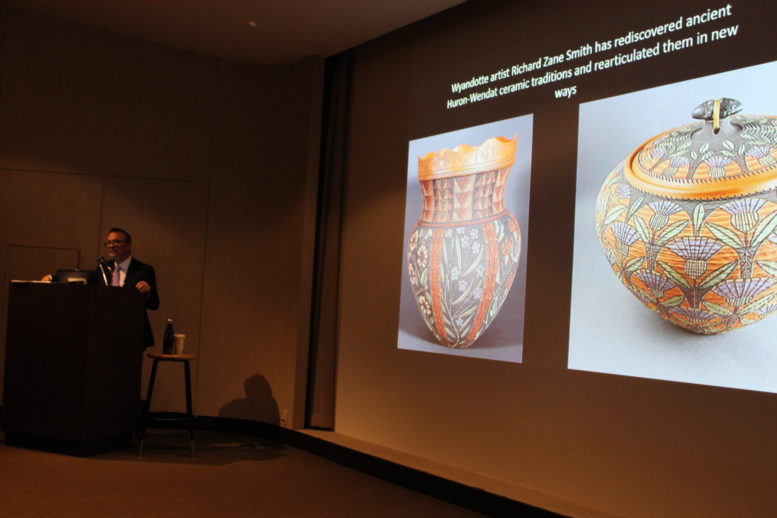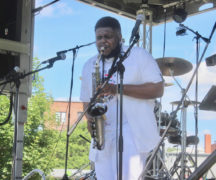By DAVID DUPONT
BG Independent News
Faced with recounting the tragic tale of native peoples being expelled from their homelands, historian Stephen Warren decided to begin on a hopeful note.
Warren spoke Saturday afternoon at the Toledo Museum of Art on “Indian Removal Then and Now: Legacies of the American Experiment with Ethnic Cleansing.” As he entered, the University of Iowa historian said he overheard someone wondering why they were there on a sunny afternoon to hear about such a “depressing” subject.
Warren, who teaches history at the University of Iowa, had anticipated such a response, so first he spoke about how the descendants of those displaced tribes pushed are doing now.
“One of the things that is important to me as an educator is to remind audiences that Native Americans are still here,” he said. “There are 567 federally recognized tribes in the United States. Their population is actually growing, not declining. Their traditions are being recovered by a lot of forward thinking, innovative people in those communities. While it’s important to acknowledge the very real hardships facing native people today and the ongoing challenges of colonialism, we also need to celebrate the very real work that native people are doing in Indian Country to continue their traditions into the 21st Century.”
The Eastern Shawnee, under the chairmanship of Glenna Wallace, now have assets worth $153 million, own the controlling interest in Peoples Bank of Seneca and have 1,700 acres in property in northeastern Oklahoma. This is a turnaround since 1970 when the tribe was broke and almost landless.
Later in the talk, he credited the development of Native American casinos as providing these assets and credited Wallace and others with trying to make sure they can turn that windfall into long-term prosperity. As his talk made clear the concern that gains by native people may prove short lived is well founded in their history of relations with Americans of European descent and the federal government.
Warren’s talk was presented in conjunction with the exhibit “Indigenous Beauty: Masterworks of American Indian Art from the Diker Collection,” now on display in the museum through May 8.
The Shawnee, Eastern Shawnee, Seneca, Wyandot and Ottawa tribes were doing well back in the early 19th century. They had recovered from the devastation caused by the War of 1812, “really a genocidal war,” Warren said. Now they were farmers, practicing Methodists, who were well integrated into the market economy. “Their reservation was a picture of prosperity.” But those accommodations were not enough to protect them. “White folks could not recognize the real success of native American economics,” he said. “They didn’t see them as human beings who were doing remarkably well.” The federal government wanted the land for settlers.
Some leaders such as Quatawepea, or Colonel Lewis, “advocated for removal.” Native people, Warren said, were constantly being harassed by settlers, their livestock slaughtered and themselves physically attacked. “There was an extraordinary amount of vigilantism.” Quatawepea worked with a coalition of 27 tribes who wanted to create an Indian state in southwestern Missouri.
Black Coat of Wapakoneta, the largest village in the region, opposed it. “For him removal was complete insanity,” Warren said. Black Coat noted his people had already been pushed inland from the coast Georgia and South Carolina, and he believed that even if they relented they would be only be moved again. But through violence and taxation, the tribes were forced out. Their land was sold to settlers, and that revenue was used, according to some, to finally pay off debts for the American Revolution. Land grants were given to officers and soldiers as compensation. And the price of the land was set to create a territory accessible only to settlers who already well off.
In September, 1835, with winter approaching, the tribes set off on foot heading to Oklahoma. Because of the corrupt federal agent in charge of removal, there wasn’t enough food provided for them. The agent had to borrow money from the tribes to buy provisions. The tribes arrived in the dead of winter with no provision or promised supplies.
The life that awaited them in northeastern Oklahoma, near the Kansas border, was hard. They survived by raising food in kitchen gardens and taking whatever odds jobs they could find, the historian said.
Though he didn’t have time to explain he did mention that within 25 years their lives were disrupted again by the Civil War, and when they return they found their settlements destroyed.
The region was a leading lead mining area. So the men went to work in the mines. The labor took a toll on them, devastating the male population, leaving behind contamination and a poisoned atmosphere.
Still, despite these hardships, the Shawnee created ceremonial, or stomp, grounds. They represent historic villages, sometimes even being named for them. They are places to gather and celebrate their heritage. Warren said: “These rituals are quite literally a means by which they can perform what it means to be Shawnee, reenact it, reclaim it. Because for removed tribes that used to call Ohio their homeland, they don’t have a place, a holy place or sacred site that they continuously inhabited for thousands of years. Remember they’ve been forcibly removed from those lands. They can’t identify through place; they have to do it in the performance of ceremony. So these rituals are vitally important.”
During the period of the Dust Bowl, Oklahoma tribes joined the migration to the West Coast where they, including a young Glenna Wallace, worked as migrant farm laborers. Some found their way back. Others found work in the shipyards. Now Warren said, 60 percent of those who claim eastern Shawnee heritage live on the West Coast.
Following the passage in 1990 of the Native American Graves and Reclamation Act, Eastern Shawnee and others are now turning their attention back to their former homelands. In particular is the interest in preserving the mound structures dating back centuries. One of the greatest examples, “an incredible reflection of Indian science,” now has a golf course constructed on top. Warren urged those in attendance to support the call to have that site declared a UNESCO Cultural Heritage site.
Warren is working with the tribes in Oklahoma to reclaim their history through a digital archive.
Warren, who described himself as a hybrid figure, a non-native often called to speak on their behalf, left the last word to Brett Barnes, who serves as gaming commissioner for his people. In a quote displayed to the audience, Barnes spoke of pride that his people survived despite obstacles. He admitted to being “bitter” with the federal government. But in the end, “we beat them at their own game” and the Eastern Shawnee “still know who we are.”
Native people survive in the face of removal, violence





